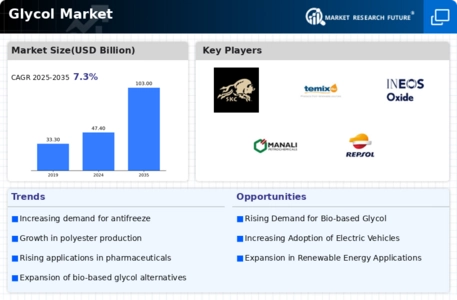Leading market players are investing heavily in research and development in order to expand their product lines, which will help the Glycol market grow even more. Market participants are also undertaking a variety of strategic activities to expand their global footprint, with important market developments including new product launches, contractual agreements, mergers and acquisitions, higher investments, and collaboration with other organizations. To expand and survive in a more competitive and rising market climate, the Glycol industry must offer cost-effective items.
Manufacturing locally to minimize operational costs is one of the key business tactics used by manufacturers in the global Glycol industry to benefit clients and increase the market sector. In recent years, the Glycol industry has offered some of the most significant advantages to several industries.
Major players in the Glycol market, including Dow, LyondellBasell Industries N.V., BASF SE, ADM, Global Bio-chem Technology Group Company Limited, DuPont Tate & Lyle Bio Products, SKC, Temix Oleo, INEOS Oxide, Huntsman International LLC, ADEKA CORPORATION, Chaoyang Chemicals, Inc., Manali Petrochemicals Limited, Haike Chemical Group Co., Ltd., Arch Chemicals Inc., Repsol, and others, are attempting to increase market demand by investing in research and development operations.
LyondellBasell is a global chemical company known for its operations in the production of polyolefins, chemicals, and refining. LyondellBasell is a major player in the chemical industry, with a diversified product portfolio that includes polyethylene, polypropylene, chemicals, advanced polymers, and refining. They serve a wide range of industries, including packaging, automotive, construction, and electronics. LyondellBasell places a strong emphasis on research and innovation. They invest in research and development to develop new materials, technologies, and solutions for various industries. Their focus on innovation often involves creating advanced plastics and polymers.
In May 2023, LyondellBasell and Neste announced a partnership to develop and commercialize sustainable glycol products made from renewable feedstocks. The two companies will collaborate on the development of new technologies and the construction of new production facilities.
BASF is a diversified company that produces a wide range of chemical products and materials with a focus on innovation and technology. Their products are used in various industries, including automotive, construction, agriculture, pharmaceuticals, and consumer goods. The company produces a broad spectrum of chemicals, polymers, and specialty materials, including engineered materials, acetyl products, and other high-performance products. Their offerings include materials used in the manufacture of everything from automotive components to consumer electronics and medical devices.
In June 2023, BASF and INVISTA announced a partnership to develop and market a new generation of sustainable glycols. The two companies will combine their expertise in catalysis and technology to develop new processes for the production of glycol from renewable feedstocks.















